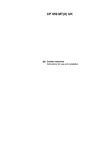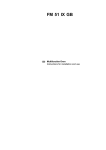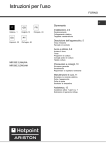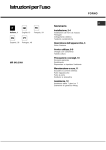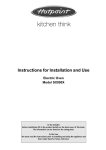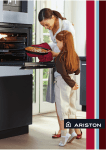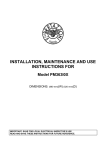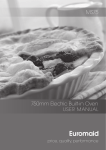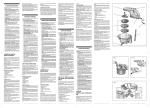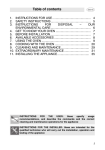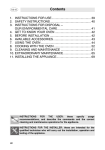Download Ariston MB 91 Specifications
Transcript
MB 91 AUS Built-in Maxioven Instructions for installation and use 2 2 Congratulations on choosing an Ariston appliance, which you will find is dependable and easy to use. We recommend that you read this manual for best performance and to extend the life of your appliance. Thank you. Close-up View D C E B A F A. Control Panel D. Electronic cooking programmer B. Knob for selecting the cooking features. E. Oven Light - When the light is on, it indicates that the oven is heating. It will turn off when the temperature setting has been reached. C. Knob for adjusting the cooking temperature. F. Glass oven door How To Use Your Appliance The "Maxioven" Ariston oven combines in a single appliance the advantages of traditional convection ovens with those of modern forced air ventilation ovens. It is an extremely versatile appliance that allows you to easily and safely choose between 9 different cooking modes. The selection of the various functions can be obtained by putting the programmer to the manual position or setting a beginning/end of cooking program (see specific chapter on page 5) and successively by turning the selector (B) and thermostat (C) knobs on the control panel. in it. Then, open the oven door and let the room air. The odour that is often detected during this initial use is due to the evaporation of substances used to protect the oven during storage and until it is installed. Convection Mode Set the termostat knob (C) between 50°C and 250°C. The outer heating elements at both the top and the bottom of the oven will come on. The heat is distributed uniformly from the top to the bottom. The convection mode is recommended for preparing meat-based dishes featuring beef or veal which require slow cooking with the addition of liquids. It still remains the best cooking mode for dry pastries and fruit in general. When cooking in convection mode, only use one dripping-pan or cooking rack at a time, otherwise the heat distribution with be uneven. Select from among the various rack heights based on the whether the dish needs more or less heat from the top or bottom. Oven light When the selector knob is in any position other than the "0" position, the oven light comes on. NOTE: to turn the oven light on without activating any of the heating elements, the selection knob (B) must be turned to the setting indicated by the symbol and the thermostat knob (C) must be set to zero indicated by the "0" symbol. Attention: The first time you use the oven we recommend that you set the thermostat on the hightest setting and leave the oven on for about a half of an hour with nothing Lower heating element Set the termostat knob (C) between 50°C and 250°C. 3 which require an extended cooking time. Moreover, the excellent heat distribution makes it possible to use lower temperatures when cooking roasts. This results in less loss of juices, meat which is more tender and a decrease in the loss of weight for the roast. The ventilated mode is especially suited for cooking fish, which can be prepared with the addition of a limited amount of condiments, thus maintaining their flavor and appearance. The ventilated mode can also be used to thaw white or red meat, fish and bread by setting the temperature to 80°-100°C. By turning the knob to this position, the oven light and lower heating element come on. This position is recommended for finishing off the cooking of food (in baking trays) which is already superficially well-cooked but still soft inside. Upper heating element Set the termostat knob (C) between 50°C and 250°C. By turning the knob to this position, the oven light and upper heathing element come on. This position is recommended for finishing off the cooking of food (in baking trays) which is already inside wellcooked but still soft superficially. To thaw Select this function to thaw more delicate foods. In this mode yuo use only the cold air circulation. Grill Important: do not set the thermostat knob (C) to over 175°C. During grilling, keep the oven door closed. Food is cooked in the grill by the downward thermal rays produced by an incandescent electric heating element. The high, direct grill temperature immediately browns meat, thus stopping juice dispersion and keeping meat more tender. The grill is particularly recommended for cooking dishes requiring a high superficial temperature. The thermostat light (E) This indicates that the oven is heating up. When the light goes out, the required temperature has been reached. When the light alternately comes on and goes out, it means that the thermostat is working properly to maintain the oven temperature. Maxigrill Important: do not set the thermostat knob (C) to over 175°C. During grilling, keep the oven door closed. Both of the heating elements of the grill are activated. For more intensive grilling, select this function. Multi-Skewer Rotisserie The Maxiovens are equipped with a removable multiple skewer rotisserie positioned parallel to the back of the oven fig. A). Slide the meat to be cooked into the spit lengthwise, keeping it in place with the adjustable forks. With kebabs, slide the meat to be cooked into the skewers provided and place them on the appropriate holders. Slide the holders, "A" and "B" in Fig. A, into the appropriate holes in the dripping-pan, rest the groove end of the rod on the guide "D" and slide the rack onto the bottom guide (Fig. B). Then slid the rod into the hole for the motor shaft and place the grooved end of the rod on the guide "C." Start the motor by turning the knob to the grill setting Ventilated Maxigrill Important: do not set the thermostat knob (C) to over 175°C. During grilling, keep the oven door closed. Both of the heating elements of the grill are activated, as well as the fan. This combination of features increases the effectiveness of the thermal radiation of the heating elements through forced air circulation of the air throughout the oven. This helps prevents foods from burning on the surface, allowing the heat to penetrate into the food. . "Gentle pastry oven" Set the termostat knob (C) between 50°C and 250°C. The lower heating element and the fan come on. This setting is ideal when cooking delicate foods, especially pastries that need to raise, because the heat rising from the bottom facilitates leavening. Please note that with this feature it takes a rather long time to reach higher temperatures in the oven. Therefore, if high temperatures are needed, we recommend that you use the "Conventional" setting. A Ventilation Mode Set the thermostat knob (C) between 50°C and 250°C. The circular heating element and the fan will come on. Since the heat remains constant and uniform throughout the oven, the air cooks and browns food uniformly over its entire surface. With this mode, you can also cook various dishes at the same time, as long as their respective cooking temperatures are the same. A maximum of 2 rack levels can be used at the same time. This cooking mode is ideal for au gratin dishes or those Fig. A 4 B Fig. B Electronic Cooking Programmer The electronic programmer has the function of automatically switching on the oven (at the required time) and switching it off at the end of the set cooking time. The 4 figure luminous display showing the actual time and the programming times, also shows the current state of the oven by means of the following symbols: Oven on Minute minder Automatic programme AUTO Point • (this divides the hour from the minutes on the display) All the functions may be programmed for a total of 23 h and 59 min. Maximum cooking time is 10 hours. Automatic oven mode (programmed cooking duration and end) • Put the food to be cooked in the oven. • Press the key (Duration) and adjust the cooking (oven time using the - and + keys: the AUTO and on) symbols light up (the oven switches on). • Press the key (end of cooking) and adjust the end of cooking time using the - and + keys: the symbol goes out (the oven switches off). • Turn the selector and the thermostat knobs onto the required function and temperature respectively. • The programmer automatically sets the start of cooking time, which is shown by the symbol (oven on) coming on. When the cooking time has elapsed, the oven is automatically switched off, the (oven on) symbol goes out and the AUTO symbol blinks; an acoustic signal sounds. Adjusting the clock (At installation, after power failures, clock in advance or behind). Select manual mode by pressing key , adjust the hour and minutes using the -and + keys. Manual oven mode (Programming excluded) Press the key ; and the oven is switched on, the (oven on) symbol AUTO symbol goes out and the comes on. This operation erases any set programme. Semi-automatic oven mode 1st example: start in manual cooking mode programmed cooking time. • Put the food to be cooked in the oven. • Press the key (duration) and adjust the cooking time using the -and + keys: the oven switches on, the AUTO and (oven on) symbols light up. • Turn the selector and the thermostat knobs onto the required function and temperature respectively. • At the end of the set cooking time, the oven is (oven on) automatically switched off, the symbol goes out and the AUTO symbol blinks; an acoustic signal sounds. 2nd example: start with manual cooking mode - end with programmed cooking mode. • Put the food to be cooked in the oven. • Press the key (end of cooking) and adjust the end of cooking time using the - and + keys: the oven switches on, the AUTO and symbols light up. • Turn the selector and the thermostat knobs onto the required function and temperature respectively. • At the end of cooking, the oven is automatically switched off, the symbol (oven on) goes out and the AUTO symbol blinks; an acoustic signal sounds. Minute minder key (minute minder) and set the time Press the required using the - and + keys. An acoustic signal sounds at the end of the programme. Buzzer The buzzer emits a sound for 7 minutes after the end of the selected programme; it may be stopped by pressing any function key. It is possible to choose 3 different types of acoustic signal. By pressing the - key the actual signal tone appears. Now, within 7 seconds, every further press of the - key changes the signal tone. Program control Press the key for the remaining time to be displayed, and the key to check the end of cooking time. Erasing programs Once a programme has been carried out, it is automatically erased; it can also be cancelled by pressing the key (manual). 5 How to Keep Your Oven in Shape Important: The appliance should be disconnected from the mains supply before starting cleaning operations. To ensure a long life cycle for the appliance, it is essential to carry out a thorough general clean frequently, while observing the following instructions: because the buildup of heat will not only impede the cooking process, but could also damage the enamel. Replacing the Lamp in the Oven • Cutoff the supply of power to the oven by turning off the omni-polar switch connecting it to the mains, or by removing the plug if it is accessible; • Unscrew the glass cover attached to the lamp holder; • Unscrew the lamp and replace it with another hightemperature lamp (300°C) with the following characteristics: - Voltage: 230/240 V - Wattage: 15W - Socket: E14 • Remount the glass cover and reconnect the appliance to the power supply. Inside the oven door: Clean the surface with a cloth moistened with hot water and non abrasive liquid detergent, then rinse and dry thoroughly. Inside the oven: • The inside of your oven is coated with a special selfcleaning microporous enamel glaze which, at a normal cooking temperature of between 200 and 300°C, oxidises and completely eliminates all grease spots or other substances that inevitably attack the inner walls of the oven. This way, cleaning is kept right down to a minimum: as a matter of fact, you just need to rub the surfaces of the oven with a wet cloth regularly, after cooking, to remove the thin layer of ash that may have been deposited during cooking, in order to maintain the self-cleaning property of the oven intact. Protective kit During operation, the oven glass door and adjacent parts of the appliance become hot. Make sure, therefore, that children do not touch the appliance. For greater safety, an additional child-safety device is available from our Head Office and our Authorised Service Centres (see enclosed list). When ordering this, please give the code: BAB - followed by the appliance model. The model is stamped on the plate which is visible on the front part of the oven upon opening the door. • After cooking where liquid has overflowed or when the dirt has not been eliminated completely (for example when grilling food, and the temperatures reached are not high enough for the full self-cleaning action of the enamel to be performed), we recommend you leave the oven on at maximum temperature so that all grease residue and the like are eliminated. • If, after long-term use, you find evident grease stains deposited on the self-cleaning oven walls, probably due to your failing to follow the above maintenance advice, clean the surfaces thoroughly with hot water and a soft cloth (do not use any detergents), then rinse and dry thoroughly. • Do not remove any dry caked-on grease using sharp objects, as these could etch the self-cleaning coating. • If the self-cleaning surfaces inside the oven are damaged or worn, due to incorrect or poor maintenance or after many years of use, you can request a kit of self-cleaning panels to line the inside of the oven. To order these, just contact an authorised Service Centre. Disassembling/assembling the oven door To make it easier to clean the inside of your oven, the oven door can be removed, by proceeding as follows (fig. 1-2): • Open the door completely and lift the 2 levers “B” (fig. 1); • Now, shutting the door slightly, you can lift it out by pulling out the hooks “A” as shown in figure 2. To reassemble the door: • With the door in a vertical position, insert the two hooks “A” into the slots; • Ensure that seat “D” is hooked perfectly onto the edge of the slot (move the oven door backwards and forward slightly); • Keep the oven door open fully, unhook the 2 levers “B” downwards and then shut the door again. Before cleaning your oven, or performing maintenance, disconnect it from the power supply. To extend the life of your oven, it must be cleaned frequently, keeping in mind that: • The self-cleaning panels and the enameled parts should be washed with warm water - abrasive powders and corrosive substances should be avoided; • The inside of the oven should be cleaned immediately after use with warm water and soap; the soap should be rinsed away and the interior dried thoroughly; • Stainless steel can be stained if it remains in contact with agressive detergents (containing phosphorus) or water with a high lime content. We recommend that you rinse these parts thoroughly and dry them well after cleaning. It is also a good idea to dry any water spills; • Never line the bottom of the oven with aluminium foil Fig 1 6 Fig 2 Practical Cooking Advice Preheating If the oven must be preheated (generally this is the case when cooking leavened foods) the "Ventilation mode" can be used to reach the desired temperaure as quickly as possible in order to save on energy. Once the food has been placed in the oven, the most appropriate cooking mode can then be selected. Baking Pastries When baking pastries, always place them in the oven after it has been preheated. Make sure you wait until the oven has been preheated thoroughly (the red "E" light will turn off). Do not open the door while the pastry is cooking in order to prevent it from dropping. Batters must not be too runny, as this will result in prolonged cooking times. In general: Using the Grill The Multifunction oven offers you three different grilling modes (see page 4). Use the “Grill” setting for grilling in perfect mode small portions like toasted sandwiches, hotdogs, etc., to perfection. The "Maxigrill" Position is the best for grilling foods rapidly. For a better distribuction of heat, not only to brown the surface but olso to cook the botton part, select “Ventilated Maxigrill” function. This mode can also be used for browning foods at the end of the cooking process. Important: always use the grill with the oven door closed. This will allow you both to attain excellent results and to save energy (10% circa). When using any of the three grilling modes, it is recommended that the thermostat knob be turned to the 175°C, as it is the most efficient way to use the grill (which utilizes infrared rays). If necessary, however, the thermostat can be set to lower temperatures by simply turning the knob to the desired setting. When utilizing the grill, place the rack at the lower levels (see cooking table). To catch grease or fat and prevent smoke, place a dripping-pan at the bottom rack level. Pastry is too dry Increase the temperature by 10°C and reduce the cooking time. Pastry dropped Use less liquid or lower the the temperature by 10°C. Pastry is too dark on top Place it on a lower rack, lower the temperature, and increase the cooking time. Cooked well on the inside but sticky on the outside Use less liquid, lower the temperature, and increase the cooking time. The pastry sticks to the pan Grease the pan well and sprinkle it with a dusting of flour. 7 Cooking Fish and Meat Meat must weigh at least 1 Kg in order to prevent it from drying out. When cooking white meat, fowl and fish, use low temperature settings (150°C-200°C). For red meat that should be well done on the outside while tender and juicy in the inside, it is a good idea to start with a high temperature setting (200°C-220°C) for a short time, then turn the oven down afterwards. In general, the larger the roast, the lower the temperature setting. Place the meat on the centre of the rack and place the dripping pan beneath it to catch the fat. Make sure that the rack is inserted so that it is in the centre of the oven. If you would like to increase the amount of heat from below, use the low rack heights. For savory roasts (especially duck and wild game), dress the meat with lard or bacon on the top. I used more than one level and they are not all at the same cooking point Use a lower temperature setting. It is not necessary to remove the food from all the racks at the same time. Cooking Pizza For best results when cooking pizza use the "Ventilation : mode" • • • • Preheat the oven for at least 10 minutes; Use a light aluminum pizza pan, placing it on the broiler supplied with the oven. If the dripping-pan is used, this will extend the cooking time, making it difficult to get a crispy crust; Do not open the oven door frequently while the pizza is cooking; If the pizza has a lot of toppings (three of four), it is recommended that the mozzarella cheese be placed on top halfway through the cooking process; STATIC OVEN COOKING Temperature Cooking time Pastries and cakes (°C) minutes Fruit pie 130 60 - 70 Meringues 130 Sponge cake 150 Type of dish Temperature Cooking time Meat (°C) hours Turkey (4-8 kg) 160 3 - 4 1/2 30 - 40 Goose (4-5 kg) 160 4 - 4 1/2 20 - 30 Duck (2-4 kg) 170 1 1/2 - 2 1/2 Type of dish Angel cake 160 40 - 50 Capon (2 1/2 - 3 kg) 170 2 - 2 1/2 Madeira cake 160 40 - 50 Braised beef (1 - 1 1/2 kg) 160 3 - 3 1/2 Chocolate cake 170 30 - 40 Leg of lamb 160 1 - 1 1/2 Flat sweet loaf 170 40 - 50 Roast hare (2 kg) 160 1 - 1 1/2 Puffs 200 15 - 20 Roast pheasant 160 1 - 1 1/2 Flaky pastry biscuits 200 15 - 20 Chicken (1 - 1 1/2 kg) 170 1 - 1 1/2 Mille feuilles 200 15 - 20 Short pastry 200 15 - 20 Fish 200 minutes 15 - 25 GRILLING Cooking time (minutes) Position of shell Chops (0.5 kg) min. 25 3rd guide rail Sausages min. 15 2nd guide rail Grilled chicken (1 kg) min. 60 1 st guide rail Type of dish Veal on the spit (0.6 kg) min. 60 - Chicken on the spit (1 kg) min. 60 - Cooking times may vary according to the nature of the foods, their homogeneity and their volume. When cooking a certain food for the first time, it is advisable to choose the lowest values in the cooking time range given in the table and then increase them if necessary. The 1 st guide rail is understood as being the lowest position. 8 Safety Is A Good Habit To Get Into • • • Qualified personnel must be contacted in the following cases: - Installation (following the manufacturer's instructions); - When in doubt about operating the appliance; - Replacing the electrical outlet when it is not compatible with the plug for the appliance. This appliance is designed for non-professional, household use and its functions must not be changed. The electrical system of this appliance may be used safely only when it is correctly connected to an efficient earthing system in complaince with the safety standards currently in effect. The manufacturer will not be held liable for any damages that might arise out of incorrect installation or improper, incorrect or unreasonable use of the appliance. Service Centres authorized by the manufacturer must be contacted in the following cases: - If in doubt about the soundness of the appliance after removing it from the packaging; - If the power supply cord has been damaged or needs to be replaced; - If the appliance breaks down or functions poorly; ask for original spare parts. The following items are potentially dangerous, and, therefore, appropriate measures must be taken to prevent children and the disabled from coming into contact with them: - Controls and the appliance in general; - Packaging (bags, polystyrene, nails, etc.); - The appliance immediately after use of the oven or grill due to the heat generated; - The appliance when no longer in use (potentially dangerous parts must be made safe). It is a good idea to do the following: - Only use the appliance to cook food, nothing else; - Check the soundness of the appliance after it has been unpacked; - Disconnect the appliance from the electrical mains if it is not functioning properly and before cleaning or performing maintenance; - When the appliance is not used for an extended period of time, cut off the supply of power and close the gas cock (if present); - Use cooking gloves to place cookware in the oven or when removing it; - Always grasp the oven door in the centre because the ends may be hot due to the escape of hot air; - Make sure that the control knobs are on the “o” setting when the appliance is not in use; - Cut the power supply chord after disconnecting it from the mains when you decide not to use the appliance any longer. Avoid the following: - Touching the appliance with wet parts of the body; - Using the appliance when barefoot; - Pulling on the appliance or the supply cord to unplug it from the electrical outlet; - Obstructing the ventilation or heat dissipation slots; - Allowing power supply cords for small appliances to come into contact with the hot parts of the appliance; - Exposing the appliance to atmospheric agents (rain, sun); - Using the oven for storage purposes; - Using flammable liquids near the appliance; - Using adaptors, multiple sockets and/or extension cords; - Attempting to install or repair the appliance without the assistance of qualified personnel. WARNING - Accessible parts will become hot when in use. To avoid burns and scalds children should be kept away 9 Installation Connecting the power supply cable to the mains The appliance must be directly connected to the mains using an omnipolar circuit-breaker with a minimum contact opening of 3 mm installed between the appliance and the mains, suitable for the load indicated and complying with current directives (the earthing wire must not be interrupted by the circuit-breaker). The power supply cable must be positioned so that it does not exceed 50°C more than room temperature at any point of its length. Before making the connection check that: l the limiter valve and the home system can support the appliance load (see data plate); l the power supply system has an efficient earthing connection which complies with the provisions of current regulations; l the socket or omnipoar circuit-breaker is easily accessible once the cooker has been installed. NOTE: do not use reducers, adaptors or shunts as they could cause overheating and burns. Important: The power supply to the appliance must be cut off before any adjustments or maintenance work is done on it. Installation of Built-in Ovens To ensure the proper working order of the built-in appliance, the kitchen unit must be of a suitable size. The sizes of the unit for installing the cooker under a worktop or in a column unit are shown in figure. min. 45 mm. A A To provide adequate ventilation, there must be appropriate ventilation openings in the front bottom and the top part of the cabinet (an intake opening on the bottom of at least 200 cm2, and an exhaust opening of at least 60 cm2). The unit panels next to the cooker must be heat resistant. In the case of veneered wood units, glues must be resistant to a temperature of 120 °C. In accordance with safety standards, once the appliance has been mounted, there must be no possible contact with electrical parts. Any protective parts must be secured so that they can only be removed with the use of tools. 50 100 150 250 200 45 A A Technical Specifications Fastening the oven Oven size width depth Height Powers supply: m 0m 472 mm 86 0 m 52 0m 469 mm 55 - Static oven: - Lower heating element: - Upper heating element: - Grill: - Maxigrill: - Ventilated Maxigrill: - Gentle pastry oven: - Ventilated oven: mm 475 mm 85 n. A F Insert the appliance into the compartment; open the oven door and fasten the oven to the cabinet using the four screws “A”, remembering to place the special spacers provided between the hole and the screw itself. mi 15 30 78 m 78 5m 89 44 7 5 m mm m 52 22 Electric oven size: mm Electric connection Cookers with a three-pole power supply cable are designed to operate with alternated current at the supply frequency and voltage indicated on the data plate (at the bottom of the oven dashboard). The earthing conductor of the cable is the yellow-green conductor. Voltage end frequency: Power supply Max: 10 cm. 54 cm. 38 cm. 33 240V 230V 2550W 1400W 1150W 2200W 3350W 3350W 1400W 3050W 2350W 1300W 1050W 2000W 3050W 3050W 1300W 2800W litres 68 230-240V / 50Hz 3400W(240V)- 3100W(230V) Xerox Business Services - Docutech MOD: "MB 91 AUS" 09/03 - 195035412.02 viale Aristide Merloni, 47 - 60044 Fabriano tel. 0732/6611 - telex 560196 - fax 0732/662954 www.Merloni.com












